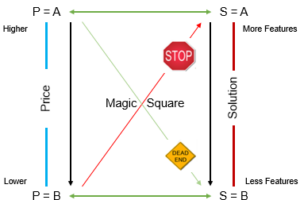
Any potential customer who tells you that your price is too high has given you a purchase obstacle you must resolve.
If they are having trouble seeing the benefits to be obtained in exchange for the price paid, there has been a failure to communicate the benefits effectively.
The worst-case scenario involves competing against a more operationally efficient business that charges less for what you do. Here, your choice in the short term is to accept a lower profit margin. This is the same problem tied to people who are only happy if they negotiate a lower price. In these two cases, your only option is to accept or reject the counteroffer.
Overview
When you hear “your price is too high,” one of the following three things is happening.
- Your target customer tells you that you are too expensive for the perceived value they are expecting. For the legitimate price objection, you have either failed to communicate the benefits effectively, or you are competing against a more operationally efficient business.
- You are dealing with a suspect who is not good at saying they aren’t interested and are using price as their excuse to escape your persuasion process.
- You are trying to persuade a person to buy from you who is only happy when they can negotiate a lower price to get a better “deal.”
No matter which of the above scenarios you are facing the key question is “What do you think is a fair price for the value I am giving you?”
If you think their price counter is fair. One that leaves you an acceptable amount of profit for the risk, costs, and efforts you have to make, then take it. Accepting fair price counters takes price out of the sales presentation, allowing you to move the sales prospect on to the what, when, and where considerations.
If you don’t think that their counter price is fair, you still need to move the sales prospect on to the what, when, and where considerations of what you are offering. The only difference is this time, you are looking to identify what you can take away from your product or how they acquire and use it that will reduce your costs so you can reduce your price and still earn the profit you require.
The key to making more money is to earn the right to increase your price by clearly providing greater benefits to your customers so they will prefer to bring their business to you. You do this when you provide more of what your customer wants, without a substantial increase in the cost of delivery. The best way to do this is to solve an irritation or remove a potential fear.
